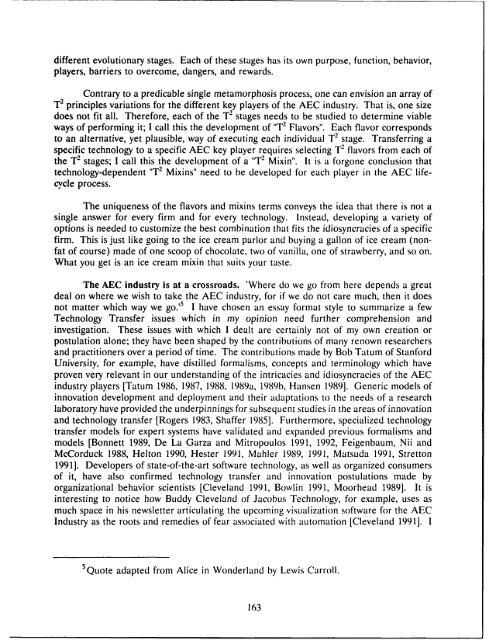Challenges and Opportunities for Innovation in the Public Works ...
Challenges and Opportunities for Innovation in the Public Works ...
Challenges and Opportunities for Innovation in the Public Works ...
You also want an ePaper? Increase the reach of your titles
YUMPU automatically turns print PDFs into web optimized ePapers that Google loves.
different evolutionary stages. Each of <strong>the</strong>se stages has its own purpose, function, behavior,<br />
players, barriers to overcome, dangers, <strong>and</strong> rewards.<br />
Contrary to a predicable s<strong>in</strong>gle metamorphosis process, one can envision an array of<br />
T 2 pr<strong>in</strong>ciples variations <strong>for</strong> <strong>the</strong> different key players of <strong>the</strong> AEC <strong>in</strong>dustry. That is, one size<br />
does not fit all. There<strong>for</strong>e, each of <strong>the</strong> T 2 stages needs to be studied to determ<strong>in</strong>e viable<br />
ways of per<strong>for</strong>m<strong>in</strong>g it; I call this <strong>the</strong> development of "T 2 Flavors". Each flavor corresponds<br />
to an alternative, yet plausible, way of execut<strong>in</strong>g each <strong>in</strong>dividual T 2 stage. Transferr<strong>in</strong>g a<br />
specific technology to a specific AEC key player requires select<strong>in</strong>g T 2 flavors from each of<br />
<strong>the</strong> T 2 stages; I call this <strong>the</strong> development of a "T 2 Mix<strong>in</strong>". It is a <strong>for</strong>gone conclusion that<br />
technology-dependent "T 2 Mix<strong>in</strong>s" need to be developed <strong>for</strong> each player <strong>in</strong> <strong>the</strong> AEC lifecycle<br />
process.<br />
The uniqueness of <strong>the</strong> flavors <strong>and</strong> mix<strong>in</strong>s terms conveys <strong>the</strong> idea that <strong>the</strong>re is not a<br />
s<strong>in</strong>gle answer <strong>for</strong> every firm <strong>and</strong> <strong>for</strong> every technology. Instead, develop<strong>in</strong>g a variety of<br />
options is needed to customize <strong>the</strong> best comb<strong>in</strong>ation that fits <strong>the</strong> idiosyncracies of a specific<br />
firm. This is just like go<strong>in</strong>g to <strong>the</strong> ice cream parlor <strong>and</strong> buy<strong>in</strong>g a gallon of ice cream (nonfat<br />
of course) made of one scoop of chocolate, two of vanilla, one of strawberry, <strong>and</strong> so on.<br />
What you get is an ice cream mix<strong>in</strong> that suits your taste.<br />
The AEC <strong>in</strong>dustry is at a crossroads. 'Where do we go from here depends a great<br />
deal on where we wish to take <strong>the</strong> AEC <strong>in</strong>dustry, <strong>for</strong> if we do not care much, <strong>the</strong>n it does<br />
not matter which way we go.' 5 I have chosen an essay <strong>for</strong>mat style to summarize a few<br />
Technology Transfer issues which <strong>in</strong> my op<strong>in</strong>ion need fur<strong>the</strong>r comprehension <strong>and</strong><br />
<strong>in</strong>vestigation. These issues with which I dealt are certa<strong>in</strong>ly not of my own creation or<br />
postulation alone; <strong>the</strong>y have been shaped by <strong>the</strong> contributions of many renown researchers<br />
<strong>and</strong> practitioners over a period of time. The contributions made by Bob Tatum of Stan<strong>for</strong>d<br />
University, <strong>for</strong> example, have distilled <strong>for</strong>malisms, concepts <strong>and</strong> term<strong>in</strong>ology which have<br />
proven very relevant <strong>in</strong> our underst<strong>and</strong><strong>in</strong>g of <strong>the</strong> <strong>in</strong>tricacies <strong>and</strong> idiosyncracies of <strong>the</strong> AEC<br />
<strong>in</strong>dustry players [Tatum 1986, 1987, 1988, 1989a, 1989b, Hansen 1989]. Generic models of<br />
<strong>in</strong>novation development <strong>and</strong> deployment <strong>and</strong> <strong>the</strong>ir adaptations to <strong>the</strong> needs of a research<br />
laboratory have provided <strong>the</strong> underp<strong>in</strong>n<strong>in</strong>gs <strong>for</strong> subsequent studies <strong>in</strong> <strong>the</strong> areas of <strong>in</strong>novation<br />
<strong>and</strong> technology transfer [Rogers 1983, Shaffer 1985]. Fur<strong>the</strong>rmore, specialized technology<br />
transfer models <strong>for</strong> expert systems have validated <strong>and</strong> exp<strong>and</strong>ed previous <strong>for</strong>malisms <strong>and</strong><br />
models [Bonnett 1989, De La Garza <strong>and</strong> Mitropoulos 1991, 1992, Feigenbaum, Nii <strong>and</strong><br />
McCorduck 1988, Helton 1990, Hester 1991, Mahler 1989, 1991, Matsuda 1991, Stretton<br />
1991]. Developers of state-of-<strong>the</strong>-art software technology, as well as organized consumers<br />
of it, have also confirmed technology transfer <strong>and</strong> <strong>in</strong>novation postulations made by<br />
organizational behavior scientists [Clevel<strong>and</strong> 1991, Bowl<strong>in</strong> 1991, Moorhead 1989]. It is<br />
<strong>in</strong>terest<strong>in</strong>g to notice how Buddy Clevel<strong>and</strong> of Jacobus Technology, <strong>for</strong> example, uses as<br />
much space <strong>in</strong> his newsletter articulat<strong>in</strong>g <strong>the</strong> upcom<strong>in</strong>g visualization software <strong>for</strong> <strong>the</strong> AEC<br />
Industry as <strong>the</strong> roots <strong>and</strong> remedies of fear associated with automation [Clevel<strong>and</strong> 1991]. I<br />
5Quote adapted from Alice <strong>in</strong> Wonderl<strong>and</strong> by Lewis Carroll.<br />
163







